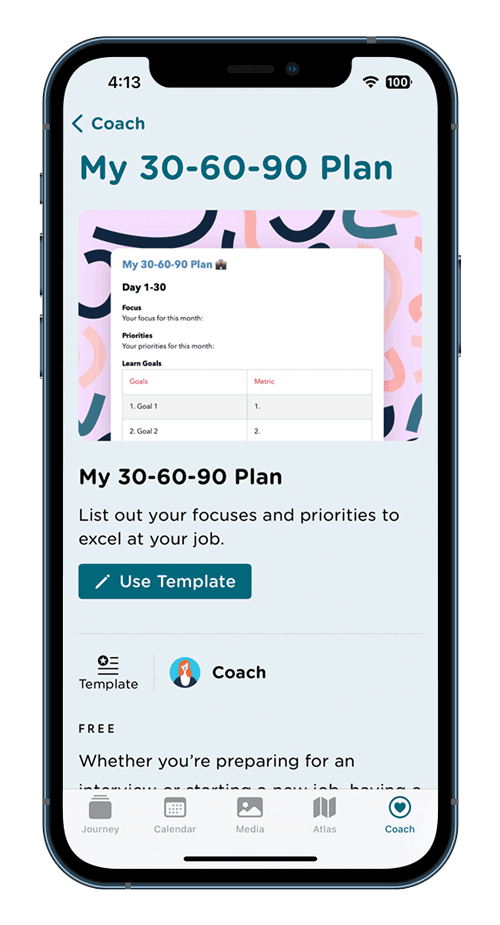The "30-60-90" Plan - Build a Roadmap to Success Professionally
Starting a new job can be daunting, especially if the unfamiliarity and pressure starts to get to you. If you're looking for a way to ease into your new role and plot some personal milestones, read on to find out how to 30-60-90 plan can help you.

In today's fast-paced and competitive professional landscape, setting yourself up for success requires careful planning, strategic thinking, and a clear roadmap to follow. Whether you're starting a new job, transitioning into a higher role, or aiming to make a significant impact within a specific timeframe, having a well-defined plan can be the key to achieving your goals. One such popular plan that has proven effective for many professionals is the "30-60-90" plan.
The "30-60-90" plan is a structured approach that enables individuals to outline their objectives, goals, and action steps for the first 30, 60, and 90 days in a new position or role. It serves as a roadmap to guide your progress, keep you focused, and maximize your impact during the critical initial months. This plan allows you to establish a strong foundation, build momentum, and demonstrate your value to your organization.

Read on to find out more about how you can explore the steps involved in creating an effective plan, its benefits, and some practical tips to help you implement your very own "30-60-90" plan successfully.
What is the "30-60-90" Plan?
The 30-60-90 plan is a strategic framework commonly used by new employees or a hiring managers to outline goals, expectations, and action steps for new employees or individuals taking on new roles. The purpose of the 30-60-90 plan is to provide a roadmap for success, allowing individuals to set clear objectives and demonstrate progress in their new role. It is typically implemented within the first three months (90 days) of employment or a new position. The plan breaks work goals or milestones down into 30-, 60- and 90-day increments and is structured around these distinct phases, each representing their specific time frame: the first 30 days, the following 30 days (60 days total), and the subsequent 30 days (90 days total).
The First 30 Days
In the initial phase, the focus is on learning and assimilation. The individual familiarizes themselves with the organization, its culture, and their specific responsibilities. They establish relationships, gather information, and gain a thorough understanding of expectations. Key activities may include training, shadowing colleagues, and setting short-term goals.
The Second 30 Days
In this phase, the individual starts to take more initiative and become actively involved in their role. They apply the knowledge and skills acquired in the first 30 days to contribute to projects, solve problems, and make independent decisions. They deepen their understanding of the organization's processes, collaborate with colleagues, and refine their goals based on feedback received.
The Third and Final 30 Days
By the third phase, the individual is expected to demonstrate a higher level of competence and independence. They actively contribute to achieving team or organizational objectives, take ownership of their work, and seek opportunities to add value. They may initiate new projects, propose improvements, or take on additional responsibilities.

8 Steps to Creating a "30-60-90" Plan
1. Understand the Role
Understanding the role in creating a "30-60-90" plan refers to gaining a comprehensive understanding of the position or role you are undertaking. It involves familiarizing yourself with the key aspects of the role, including its responsibilities, expectations, and objectives. This would typically include carefully reading and analyzing the job description provided by your employer. While you do this, pay attention to the specific tasks, responsibilities, and qualifications outlined in the description. This will give you a foundational understanding of what is expected in your role.
Take the time to familiarize yourself with the organization you are joining. Learn about its mission, values, culture, and industry. Understand its position in the market and any current initiatives or challenges it may be facing. This knowledge will provide context and help you align your efforts with the organization's objectives. For more information, identify the key stakeholders associated with your role. These may include your manager, colleagues, clients, or other departments you will interact with. Understanding the relationships and dynamics with these stakeholders will enable you to navigate your role more effectively.
2. Identify Key Objectives
This refers to determining the main goals or outcomes you aim to achieve within each phase of the plan. These objectives should be specific to your role and aligned with the overall objectives of the organization as well.
Based on your understanding of the role, identify the key areas where you can make a significant impact and contribute to the organization, such as knowledge acquisition, skill development, project involvement, and relationship building. Consider the responsibilities outlined in the job description and any additional goals set by your manager.

3. Break Down the Timeframes
Start drafting your plan by dividing the 90-day plan into the three distinct phases: the first 30 days, the following 30 days (60 days total), and the subsequent 30 days (90 days total). Determine which objectives are most appropriate for each phase, considering the learning curve and the progressive nature of the plan.

If you're looking for a place that you can efficiently start inputting your objectives into the 30-60-90 time frames, Journey’s 30-60-90 plan template already has the timeframes laid out for you to fill in. In this template, you can list your objectives, focuses, and priorities for days 1 to 30, days 31 to 60, and days 61 to 90. With the time frames, sections for you to list your specific goals, and be able to prioritize them into a list into the table that's provided, all you have to focus on is deciding on your key objectives and inputting it into the template.
4. Set SMART Goals
While determining your objectives, ensure that they are objectives are "S.M.A.R.T" specific, measurable, achievable, relevant, and time-bound Specific objectives are clear and well-defined, measurable objectives can be quantified or assessed, achievable objectives are realistic and within reach, relevant objectives align with your role and the organization's goals, and time-bound objectives have a specific timeframe for completion.
By taking time to identify key objectives, you set clear targets for each phase of the plan. These objectives serve as a guide for your activities and actions, helping you stay focused and motivated throughout the 30-60-90 period. They enable you to measure your progress, track your achievements, and ensure that your efforts are aligned with the expectations of your role and the overall objectives of the organization.
5. Determine Action Steps
Next, break down each goal into actionable steps or tasks. Consider the resources, support, or training required to accomplish these steps. Outline the specific actions you will take to achieve each goal within the designated timeframe. If you had chosen to use Journey's "My 30-60-90 Plan" template, you can state some action steps you can take to meet your objectives, focuses, and goals as well!
6. Seek Input and Alignment
Share your plan with relevant stakeholders, such as your manager or supervisor, and seek their input, feedback, and alignment. This step is important to ensure that your goals and action steps are in line with the expectations and priorities of the organization. Seeking input and alignment is crucial as it allows you to incorporate valuable perspectives and ensure that your plan is well-aligned with the organization's goals and expectations. It demonstrates your commitment to collaboration, open communication, and shared success. By actively involving your manager or supervisor in the process, you enhance the likelihood of achieving your objectives and receiving the necessary support to excel in your role.
Schedule a meeting or discussion with your manager or supervisor to present your 30-60-90 plan. Provide them with a clear overview of the objectives, action steps, and timelines you have set for each phase. Through this, engage in a conversation to ensure that your plan aligns with the expectations and goals of the organization. Seek clarity on any specific objectives or initiatives that the organization is prioritizing during the 30-60-90 timeframe.
7. Monitor Progress

Monitoring progress ensures that you stay accountable, maintain focus, and make informed decisions throughout the 30-60-90 plan. It enables you to stay on top of your goals, identify areas of improvement, and maximize your performance. By regularly evaluating your progress, you can make timely adjustments, celebrate milestones, and ultimately achieve the desired outcomes of the plan.
Schedule regular check-ins with yourself or with your manager to assess your progress. These can be weekly, bi-weekly, or monthly meetings to review your achievements, discuss challenges, and evaluate your overall performance. Identify key metrics or indicators that align with your goals and action steps. These can be quantifiable measures of success or progress, such as sales targets, project milestones, customer satisfaction ratings, or personal skill development. Continuously monitor these metrics and track your performance against them.
You should also take time to reflect on your accomplishments and milestones reached during each phase of the plan. Celebrate your successes and acknowledge the progress made towards your objectives. This reflection boosts motivation and reinforces a sense of achievement.
8. Evaluate and Reflect
At the end of each phase, evaluate your progress and achievements. Evaluation and reflection are essential steps in the "30-60-90" plan as they promote continuous improvement and personal growth. By critically assessing your performance and experiences, you gain valuable insights into your strengths, weaknesses, and areas for development. These insights can guide your future actions, helping you refine your approach, overcome challenges, and achieve greater success in your role.

Evaluate the extent to which you have achieved the goals and objectives set for each phase of the plan. Compare your actual performance against the desired outcomes. Celebrate the accomplishments and identify any goals that were not fully met. Take the time to reflect on the actions, strategies, and approaches you employed to work towards your goals. Evaluate their effectiveness and identify which ones yielded the best results. Consider whether any adjustments or improvements can be made to enhance your future performance.
The 30-60-90 plan provides a structured framework for individuals to demonstrate their capabilities, align their efforts with organizational goals, and build a foundation for long-term success. It helps establish clear expectations, facilitates communication between managers and employees, and serves as a guide for performance evaluation and feedback.
Remember, the 30-60-90 plan serves as a guide, but flexibility is essential. Adapt your plan as circumstances evolve and new opportunities arise. Regularly communicate your progress to your manager or supervisor to ensure alignment and demonstrate your commitment to success in your new role.


